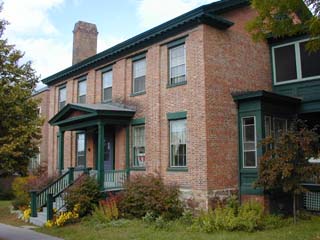

|
278 Main Street Mark Rice House-YWCA Built: 1806 Listed on the National Register of Historic Places |
 |
The Mark Rice House at 278 South Union Street was constructed in 1806. This five-by-two bay brick structure has undergone many additions however, remains one of Burlington's earliest examples of a federal style home. The oldest part of the house faces Main Street and sits on a foundation of coursed yellowstone that was mined from Willard's quarry, which was located on what is know Shelburne Road. The porches, additions from 1886, are all in the Italianate style. The rear ell of the building, which sits on a redstone foundation, may be an 1850 addition as it is more traditional of the Greek Revival Style.(1) In 1898, Dr. Lyman Allen, the owner at the time, installed a fireplace on the southwest side of the house.
The original occupant, Mr. Mark Rice, was a chairmaker and helped to found Burlington's Unitarian Church in 1810. The Windsor style chairs constructed by Rice at a shop just west of his home are now collector' items. Rice died in Burlington in 1829 at the age of 61. He is buried in the Elmwood Cemetery. From the inscription on his gravestone, Rice was a Massachusetts native and according to his obituary in the Free Press, relocated from Boston sometime before 1794. The property was left to his second wife who, within a month of his death, put the house up for sale.
The house changed hands several times over the next twenty-one years. From 1829-1832 Charles Adams, a Burlington attorney owned the home. Between 1832 and 1839 another attorney by the name of George Allen owned the home, although it is not believed that he actually resided here. Charles DeForest Kasson, yet another lawyer, purchased the house in 1839 for $3000 and lived here until 1850.
From 1850-1858, Francis K. Nichols took up residence at 278 South Union Street. Calvin Blodgett was the next owner of the home. Blodgett, a prominent businessman in Burlington shared this home with his wife and family until 1877. He and his sons ran a successful lumber business and were considered pioneers in the pine lumber trade from Canada to Michigan. His son, Calvin H. Blodgett went on to become mayor of Burlington in 1873, the same year of his death. His wife Luthera, maintained ownership of the house until her own death in 1877. At the time of her death, the Burlington City Directory also listed A.P. Grinnell as a tenant at 278 South Union Street. Grinnell, dean of the University of Vermont's College of Medicine from 1874-1877 and 1882-1898, later went on to purchase the property in 1892. The house, which now contained an additional apartment acted as both home and office to several people aside from him and was eventually sold to a Dr. Lyman Allen in the year 1900.
Lyman Allen, a Burlington native, lived in the house for the next sixty-one years. In 1896, Lyman Allen received his medical degree from the University of Vermont. He interned at Boston City Hospital from 1897-1898 when he returned to Burlington to continue his medical career. Allen served on the faculty of the College of Medicine from 1924-1944 and also acted as Chief of Surgery at the Mary Fletcher Allen Hospital. He died in 1961 at the age of 88.
After his death the house lay vacant for two years. In early March of 1963, the Young Women's Christian Association began a campaign to raise money to purchase the property. By July of that same year the first tenants moved in under their ownership. In 1991 the house underwent renovations and now serves as a shelter for women in need of home or help.(2)
Source:
1. National Register of Historic Places Inventory--Nomination Form. (Washington, D.C.: United States Department of the Interior, National Park Service, 1970).
2. David Blow, Historic Guide to Burlington Neighborhoods. Vol. 2. Lilian Baker Carlisle, ed. (Burlington, Vermont: Chittenden County Historical Society, 1991); Vermont Historic Sites and Structures Survey (Burlington, Vermont: Vermont Division for Historic Preservation, 1990).
Introduction | 1830 Young map | 1830-1988 overlay maps | Street index | Surviving 1830 buildings | UVM Historic Preservation Program